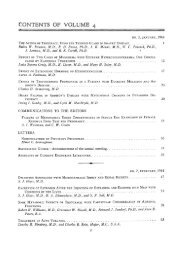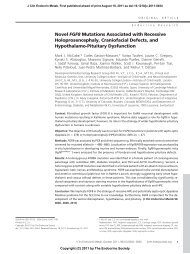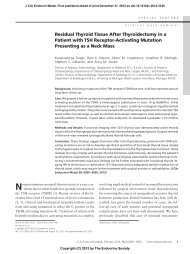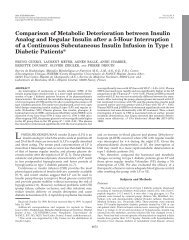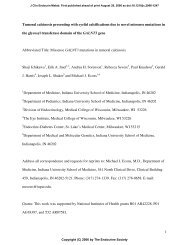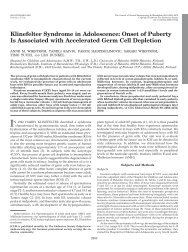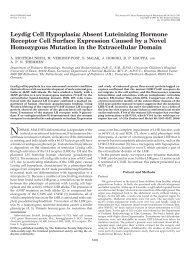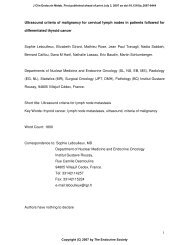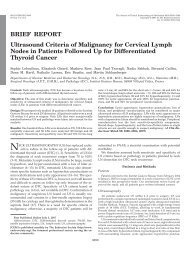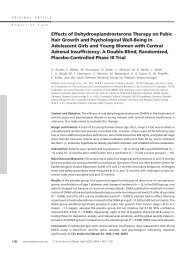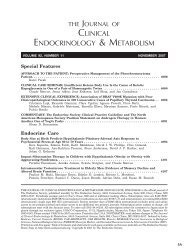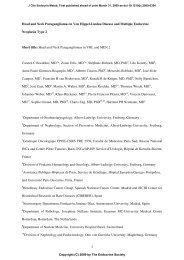The Effects Of Exercise-Induced Weight Loss On - The Journal of ...
The Effects Of Exercise-Induced Weight Loss On - The Journal of ...
The Effects Of Exercise-Induced Weight Loss On - The Journal of ...
Create successful ePaper yourself
Turn your PDF publications into a flip-book with our unique Google optimized e-Paper software.
J Clin Endocrinol Metab, April 2010, 95(4):1609–1616 jcem.endojournals.org 1615<br />
with exercise, although only significantly for AG. <strong>The</strong> increase<br />
in the amplitude <strong>of</strong> change <strong>of</strong> AG observed with the<br />
exercise intervention was due to the increase in fasting AG<br />
and not to a more pronounced decrease after the breakfast<br />
meal. However, it is important to acknowledge that before<br />
the exercise intervention, when participants were sedentary,<br />
AG plasma levels were irresponsive to food intake.<br />
This pattern was changed after 12 wk <strong>of</strong> exercise with an<br />
associated 3.5-kg average weight loss. Unfortunately, reports<br />
on the impact <strong>of</strong> weight loss or changes in physical<br />
activity levels on the postprandial release <strong>of</strong> AG are limited,<br />
and from our knowledge only one study has looked<br />
at the role <strong>of</strong> body weight on AG postprandial secretion<br />
(18). Zwirska-Korczala et al. (18) reported a significant<br />
suppression <strong>of</strong> AG after the ingestion <strong>of</strong> a mixed meal in<br />
normal-weight women, but not in moderately or morbidly<br />
obese women with the metabolic syndrome. <strong>The</strong>se findings<br />
are consistent with our results and suggest that obesity<br />
is characterized by the maintenance <strong>of</strong> high levels <strong>of</strong> AG<br />
which may supply a constant feeding drive in these individuals.<br />
We have shown that this “abnormal” pattern can<br />
be changed with exercise-induced weight loss.<br />
We have also previously reported that exercise improves<br />
the ability to adjust EI according to previous food consumption<br />
(energy compensation) in both normal-weight (22) and<br />
overweight/obese sedentary individuals (Martins, C., B.<br />
Kulseng, N. A. King, and J. E. Blundell, submitted for publication).<br />
<strong>The</strong>se findings suggest that sedentary individuals<br />
suffer from a malfunctioning or insensitive appetite control<br />
system that can be ameliorated by exercise.<br />
Another important outcome <strong>of</strong> this study was the fact<br />
that the increase in fasting AG plasma levels and hunger<br />
(as well as other appetite) sensations, in response to the<br />
12-wk exercise program, were unrelated to the magnitude<br />
<strong>of</strong> weight loss. This finding challenges the hypothesis that<br />
these changes are part <strong>of</strong> a homeostatic compensatory<br />
mechanism to restore EB. If this was the case, these<br />
changes would be expected to increase with the magnitude<br />
<strong>of</strong> weight loss. However, we are aware that our study has<br />
a small sample size and more power is required to detect<br />
such associations. Moreover, because all our participants<br />
lost weight with the exercise intervention, it is difficult to<br />
speculate whether the observed changes were a result <strong>of</strong><br />
weight loss or exercise per se. <strong>On</strong>ly a study with sufficient<br />
power and where exercise is performed in EB (by matching<br />
the energy costs <strong>of</strong> exercise with an equivalent increase in<br />
EI) and energy deficit can clearly establish whether the<br />
increase in fasting hunger feelings and AG plasma levels is<br />
a result <strong>of</strong> weight loss (and therefore part <strong>of</strong> a compensatory<br />
homeostatic mechanism) or exercise.<br />
We can conclude that although exercise-induced<br />
weight loss leads to an increase in fasting AG and hunger<br />
sensations, similar to what has been reported in response<br />
to dietary-induced weight loss, exercise appears to balance<br />
this increased orexigenic drive by improving the satiety<br />
response to a meal and the sensitivity <strong>of</strong> the appetite control<br />
system.<br />
Acknowledgments<br />
We thank all the participants that took part in this study for their<br />
time and enthusiasm, and Mrs. Sissel Salater, Trude Haugen, and<br />
Ingrid Hals for technical and clinical assistance.<br />
Address all correspondence and requests for reprints to: C.<br />
Martins, Obesity Research Group, Department <strong>of</strong> Cancer Research<br />
and Molecular Medicine, Faculty <strong>of</strong> Medicine, Norwegian<br />
University <strong>of</strong> Science and Technology, 7489 Trondheim,<br />
Norway. E-mail: catia.martins@ntnu.no.<br />
C.M. was supported by postdoctoral Grant SFRH/BPD/<br />
36940/2007 from Fundação para a Ciência e Tecnologia (Portugal)<br />
under the Third European Union Community Support<br />
Program. J.J.H. was supported by the Danish Medical Research<br />
Council and Danorc. J.E.B. was supported by the Biotechnology<br />
and Biological Sciences Research Council (BBS/B/05079). We<br />
also thank the Norwegian Research Council in partnership with<br />
the Institute for Cancer Research and Molecular Medicine, Faculty<br />
<strong>of</strong> Medicine, Norwegian University <strong>of</strong> Science and Technology,<br />
Trondheim, Norway, for financial support.<br />
Disclosure Summary: <strong>The</strong> authors have nothing to disclose.<br />
References<br />
1. World Health Organization 2003 Global strategy on diet, physical<br />
activity and health—obesity and overweight. http://www.who.int/<br />
hpr/NPH/docs/gs_obesity.pdf<br />
2. World Health Organization 2006 Obesity and overweight—fact<br />
sheet no. 311. http://www.who.int/mediacentre/factsheets/fs311/<br />
en/print.html<br />
3. King NA, Hopkins M, Caudwell P, Stubbs RJ, Blundell JE 2008<br />
Individual variability following 12 weeks <strong>of</strong> supervised exercise:<br />
identification and characterization <strong>of</strong> compensation for exerciseinduced<br />
weight loss. Int J Obes (Lond) 32:177–184<br />
4. Epstein LH, Wing RR 1980 Aerobic exercise and weight. Addict<br />
Behav 5:371–388<br />
5. King NA, Caudwell P, Hopkins M, Byrne NM, Colley R, Hills AP,<br />
Stubbs JR, Blundell JE 2007 Metabolic and behavioral compensatory<br />
responses to exercise interventions: barriers to weight loss. Obesity<br />
(Silver Spring) 15:1373–1383<br />
6. Doucet E, Cameron J 2007 Appetite control after weight loss: what<br />
is the role <strong>of</strong> bloodborne peptides? Appl Physiol Nutr Metab 32:<br />
523–532<br />
7. Martins C, Morgan L, Truby H 2008 A review <strong>of</strong> the effects <strong>of</strong><br />
exercise on appetite regulation: an obesity perspective. Int J Obes<br />
(Lond) 32:1337–1347<br />
8. Foster-Schubert KE, McTiernan A, Frayo RS, Schwartz RS, Rajan<br />
KB, Yasui Y, Tworoger SS, Cummings DE 2005 Human plasma<br />
ghrelin levels increase during a one-year exercise program. J Clin<br />
Endocrinol Metab 90:820–825<br />
9. Leidy HJ, Gardner JK, Frye BR, Snook ML, Schuchert MK, Richard<br />
EL, Williams NI 2004 Circulating ghrelin is sensitive to changes in<br />
body weight during a diet and exercise program in normal-weight<br />
young women. J Clin Endocrinol Metab 89:2659–2664



